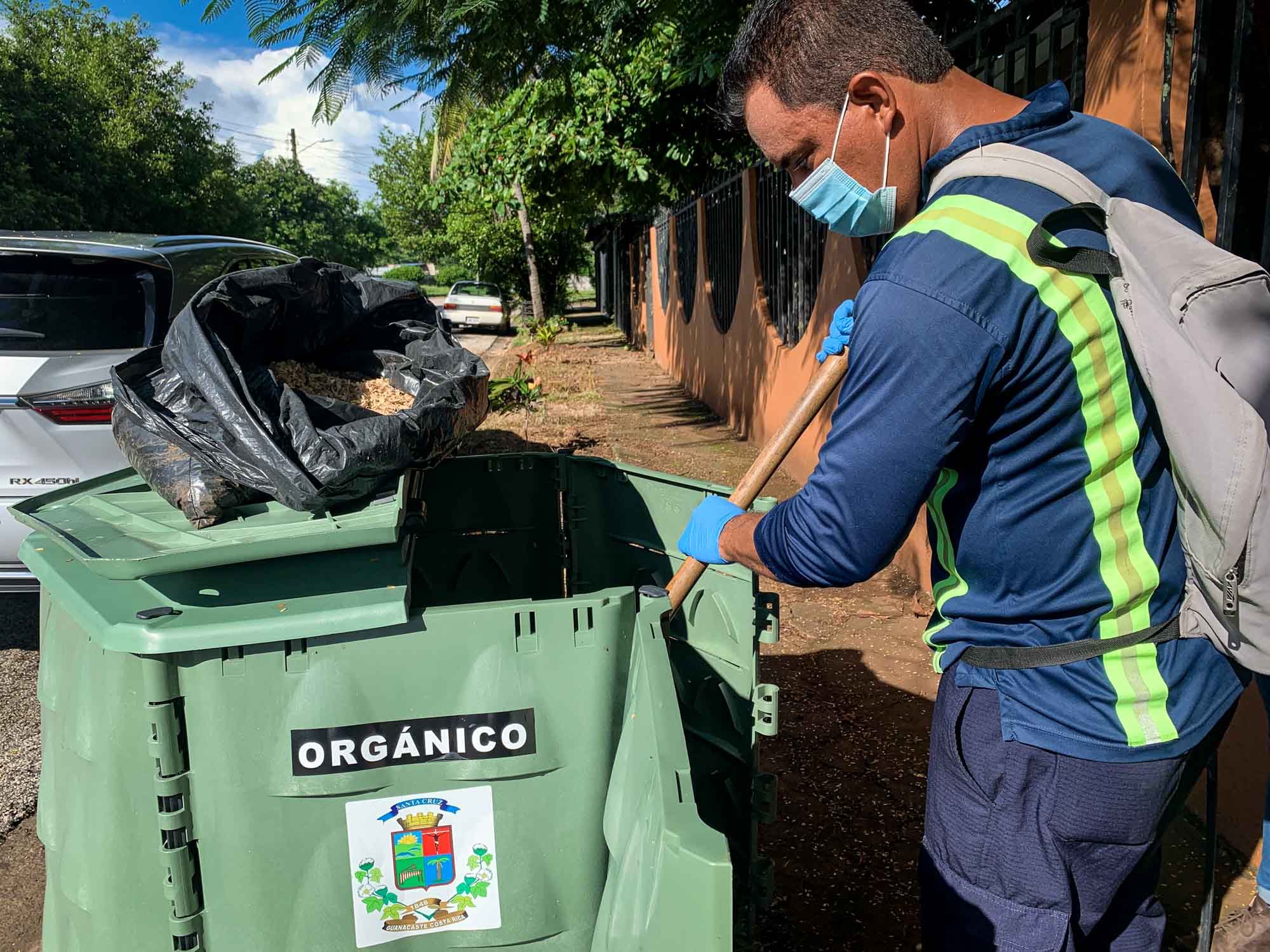
Eighty families who live in the Corobici neighborhood in Santa Cruz now have the opportunity to put their organic waste to a better purpose with the community composting pilot project launched by the Municipality of Santa Cruz on September 4.
In composting, organic matter —usually food scraps— breaks down naturally in the presence of oxygen. Once the process is finished, it becomes organic compost.
In the Corobici neighborhood, residents have 10 compost bins where they can take their organic waste three times a week at a time assigned by areas. The compost bins are strategically placed less than 100 meters apart from each other so that families are guaranteed that they don’t have to walk far to deposit their waste.
There, municipal employees —who also clean the drain pipes and sidewalks— evaluate and accept the waste to deposit what will contribute to the best composting quality.
Both community members and municipal staff received training to learn how to select, store and deposit the waste. The environmental department also tested a compost bin for four months, which indicated to them types of waste and the best way to dispose of them.
“We started to test [the test compost] with organic waste from the Santa Cruz farmer’s market, but later we switched to waste from a produce store because the [waste] from the market wasn’t quality,” said the environmental educator from the department of environmental management, Katia Gomez.
That’s why municipal employees evaluate the organic waste from the neighborhood before depositing it in the compost bins. For example, they can’t accept scraps that are in an advanced state of decomposition, excreted matter, meat scraps or oils. “In the end, the compost will be for the community itself, be it for a community vegetable garden or flower gardens,” explained Gomez.
Hellen Camacho, who lives in the neighborhood and is vice president of the neighborhood’s development association, said the project’s benefits are seen at home and in the impact on the environment. “We are adapting to taking the needed time and separating, but this has been improving that part of the garbage no longer has liquids,” she cited as an example.
We educate ourselves to reduce the level of garbage we throw away, to reuse the organic product and, in addition, the most important thing is that it contributes to the environment in a significant way because this type of waste produces gases that affect the ozone layer and causes more serious climate change,” she added.
The local government will evaluate the project in January to make decisions on how to improve it, what things were good and what opportunities there are for improvement, whether to continue, to stop it or expand to another community.
The development association will also visit the houses in the neighborhood this week to remind residents of the schedule for collecting organic waste and the processes they should follow. Camacho said they could even poll how many families are participating in the project.
“What I see is that it still needs to become a habit, but I say that by reviewing it with them, the initiative is being formed,” Camacho commented.
It was decided that the Corobici neighborhood should be the first to participate in this project because the recycling pilot plan was carried out in that same place in 2009. Currently, the municipality uses the same garbage collection route for normal garbage and for recycling, just with different frequencies. Both achieve 95% coverage of the canton, said Gomez.
For Lower Emissions
The composting project came about after the results of the latest greenhouse gas inventory, which was carried out by the local government in 2018. In the study, they identified that the main sources of emissions are livestock, transportation and waste.
“We made a proposal for mitigation actions. With regard to livestock and transportation, it’s a bit more complicated because they aren’t in the hands of the municipality, but the waste is more within our reach,” the official explained. “That’s where the idea of the community composting pilot plan came from.”
According to Gomez, the local government and the environmental department are drafting regulations to prohibit communities from depositing organic waste in with normal garbage. “But we are very aware that we can’t prohibit something without providing training. That’s why we intend to provide all the tools so that households know how to process them,” she explained.
A National Plan
Municipal employees in charge of collecting both normal and recoverable wastes— in other words, recycling— take them to the Environmental Technology Park (PTA- Parque Tecnológico Ambiental), which also receives waste from the cantons of Hojancha, Nandayure, La Cruz, Nicoya and Carrillo, in addition Santa Cruz.
The PTA was inaugurated in December of 2020, made with an investment of ₡264.5 million (about $440,000) from the National Development Institute (INDER) and the local government. It is part of the Comprehensive Waste Management Action Plan launched by the national government in March of this year, which also includes the 2020-2050 National Composting Plan. Both are part of the National Decarbonization Plan.
There, municipal employees and collaborators from the canton do separated waste management. The local government also plans to set up a forest nursery, a butterfly farm, a composting center and trails, Gomez commented.
The main benefit of doing this differentiated collection is environmental, but the communities also benefit,” said Gomez. “The PTA provides social and economic development to communities with jobs for five people from Cacao and five from Bernabela,” she added.
In Costa Rica, more than half of the waste is of organic origin, the government calculated in its National Composting Plan. Do you want to know more about how to create a compost bin? Take a look at this guide prepared by the National University.







Comments